醋酸氟轻松

醋酸氟轻松结构式

|
常用名 | 醋酸氟轻松 | 英文名 | Fluocinolone Acetonide |
|---|---|---|---|---|
| CAS号 | 67-73-2 | 分子量 | 452.488 | |
| 密度 | 1.4±0.1 g/cm3 | 沸点 | 578.5±50.0 °C at 760 mmHg | |
| 分子式 | C24H30F2O6 | 熔点 | 267-269 °C(lit.) | |
| MSDS | 中文版 美版 | 闪点 | 303.7±30.1 °C | |
| 符号 |

GHS07 |
信号词 | Warning |
醋酸氟轻松用途Fluocinolone Acetonide是糖皮质激素衍生物,可作用于各种皮肤病。 |
| 中文名 | 醋酸氟轻松 |
|---|---|
| 英文名 | fluocinolone acetonide |
| 中文别名 | 醋酸肤轻松 | 肤轻松 | 氟轻松 | 仙乃乐 | 11b-羟基-16a,17-[(1-甲基亚乙基)-双(氧)]-21-(乙酰氧基)-6a,9-二氟孕甾-1,4-二烯-3,20-二酮 | 乙酸肤轻松 |
| 英文别名 | 更多 |
| 描述 | Fluocinolone Acetonide是糖皮质激素衍生物,可作用于各种皮肤病。 |
|---|---|
| 相关类别 | |
| 参考文献 |
| 密度 | 1.4±0.1 g/cm3 |
|---|---|
| 沸点 | 578.5±50.0 °C at 760 mmHg |
| 熔点 | 267-269 °C(lit.) |
| 分子式 | C24H30F2O6 |
| 分子量 | 452.488 |
| 闪点 | 303.7±30.1 °C |
| 精确质量 | 452.201050 |
| PSA | 93.06000 |
| LogP | 2.24 |
| 蒸汽压 | 0.0±3.6 mmHg at 25°C |
| 折射率 | 1.577 |
| 储存条件 | Refrigerator |
| 分子结构 | 五、分子性质数据: 1、 摩尔折射率:109.50 2、 摩尔体积(m3/mol):330.3 3、 等张比容(90.2K):890.0 4、 表面张力(dyne/cm):52.7 5、 极化率(10-24cm3):43.41 |
| 计算化学 | 1.疏水参数计算参考值(XlogP):无 2.氢键供体数量:2 3.氢键受体数量:8 4.可旋转化学键数量:2 5.互变异构体数量:3 6.拓扑分子极性表面积93.1 7.重原子数量:32 8.表面电荷:0 9.复杂度:960 10.同位素原子数量:0 11.确定原子立构中心数量:9 12.不确定原子立构中心数量:0 13.确定化学键立构中心数量:0 14.不确定化学键立构中心数量:0 15.共价键单元数量:1 |
| 更多 | 1. 性状:白色或近白色结晶性粉末,无味 2. 密度(g/mL,25/4℃):不确定 3. 相对蒸汽密度(g/mL,空气=1):不确定 4. 熔点(ºC):267-269 (lit.) 5. 沸点(ºC,常压):不确定 6. 沸点(ºC, 5.2kPa):不确定 7. 折射率:103 ° (C=1, MeOH) 8. 闪点(ºC):不确定 9. 比旋光度(º):不确定 10. 自燃点或引燃温度(ºC):不确定 11. 蒸气压(kPa,25ºC):不确定 12. 饱和蒸气压(kPa,60ºC):不确定 13. 燃烧热(KJ/mol):不确定 14. 临界温度(ºC):不确定 15. 临界压力(KPa):不确定 16. 油水(辛醇/水)分配系数的对数值:不确定 17. 爆炸上限(%,V/V):不确定 18. 爆炸下限(%,V/V):不确定 19. 溶解性:不溶于水,易溶于丙酮,在乙醇、氯仿中溶解,在乙醚中微溶 |
| 符号 |

GHS07 |
|---|---|
| 信号词 | Warning |
| 危害声明 | H315-H319-H335 |
| 警示性声明 | P261-P305 + P351 + P338 |
| 个人防护装备 | dust mask type N95 (US);Eyeshields;Gloves |
| 危害码 (欧洲) | Xn:Harmful |
| 风险声明 (欧洲) | R20/21/22;R36/37/38;R40 |
| 安全声明 (欧洲) | S26-S36-S22 |
| 危险品运输编码 | NONH for all modes of transport |
| WGK德国 | 3 |
| RTECS号 | TU3830000 |
| 海关编码 | 2937210000 |
|
~% 
醋酸氟轻松 67-73-2 |
| 文献:Journal of Labelled Compounds and Radiopharmaceuticals, , vol. 53, # 5-6 p. 260 - 265 |
|
~% 
醋酸氟轻松 67-73-2 |
| 文献:Spectrochimica Acta - Part A: Molecular and Biomolecular Spectroscopy, , vol. 75, # 2 p. 930 - 935 |
|
~% 
醋酸氟轻松 67-73-2 |
| 文献:Journal of Labelled Compounds and Radiopharmaceuticals, , vol. 52, # 4 p. 103 - 109 |
|
~% 
醋酸氟轻松 67-73-2 |
| 文献:Molecules, , vol. 16, # 3 p. 2658 - 2671 |
|
~% 
醋酸氟轻松 67-73-2 |
| 文献:Molecules, , vol. 16, # 3 p. 2658 - 2671 |
|
~% 
醋酸氟轻松 67-73-2 |
| 文献:Molecules, , vol. 16, # 3 p. 2658 - 2671 |
|
~% 
醋酸氟轻松 67-73-2 |
| 文献:Molecules, , vol. 16, # 3 p. 2658 - 2671 |
|
~% 
醋酸氟轻松 67-73-2 |
| 文献:Molecules, , vol. 16, # 3 p. 2658 - 2671 |
| 海关编码 | 2937210000 |
|---|
|
Translating clinical findings into knowledge in drug safety evaluation--drug induced liver injury prediction system (DILIps).
J. Sci. Ind. Res. 65(10) , 808, (2006) Drug-induced liver injury (DILI) is a significant concern in drug development due to the poor concordance between preclinical and clinical findings of liver toxicity. We hypothesized that the DILI typ... |
|
|
Convenient QSAR model for predicting the complexation of structurally diverse compounds with β-cyclodextrins
Bioorg. Med. Chem. 17 , 896-904, (2009) This paper reports a QSAR study for predicting the complexation of a large and heterogeneous variety of substances (233 organic compounds) with beta-cyclodextrins (beta-CDs). Several different theoret... |
|
|
Multi-target spectral moment QSAR versus ANN for antiparasitic drugs against different parasite species.
Bioorg. Med. Chem. 18 , 2225-31, (2010) There are many of pathogen parasite species with different susceptibility profile to antiparasitic drugs. Unfortunately, almost QSAR models predict the biological activity of drugs against only one pa... |
| (4aS,4bR,5S,6aS,6bS,9aR,10aS,10bS,12S)-4b,12-difluoro-5-hydroxy-6b-(hydroxyacétyl)-4a,6a,8,8-tétraméthyl-4a,4b,5,6,6a,6b,9a,10,10a,10b,11,12-dodécahydro-2H-naphto[2',1':4,5]indéno[1,2-d][1,3]dioxol-2-one |
| (4aS,4bR,5S,6aS,6bS,9aR,10aS,10bS,12S)-4b,12-difluoro-5-hydroxy-6b-(hydroxyacetyl)-4a,6a,8,8-tetramethyl-4a,4b,5,6,6a,6b,9a,10,10a,10b,11,12-dodecahydro-2H-naphtho[2',1':4,5]indeno[1,2-d][1,3]dioxol-2-one |
| 2H-Naphth[2',1':4,5]indeno[1,2-d][1,3]dioxol-2-one, 4b,12-difluoro-4a,4b,5,6,6a,6b,9a,10,10a,10b,11,12-dodecahydro-5-hydroxy-6b-(2-hydroxyacetyl)-4a,6a,8,8-tetramethyl-, (4aS,4bR,5S,6aS,6bS,9aR,10aS,10bS,12S)- |
| EINECS 200-668-5 |
| (4aS,4bR,5S,6aS,6bS,9aR,10aS,10bS,12S)-4b,12-difluoro-5-hydroxy-6b-(hydroxyacetyl)-4a,6a,8,8-tetramethyl-4a,4b,5,6,6a,6b,9a,10,10a,10b,11,12-dodecahydro-2H-naphtho[2',1':4,5]indeno[1,2-d][1,3]dioxol-2 |
| 6a,9a-Difluoro-16a-hydroxyprednisolone 16,17-acetonide |
| MFCD00010525 |
| (4aS,4bR,5S,6aS,6bS,9aR,10aS,10bS,12S)-4b,12-Difluor-5-hydroxy-6b-(hydroxyacetyl)-4a,6a,8,8-tetramethyl-4a,4b,5,6,6a,6b,9a,10,10a,10b,11,12-dodecahydro-2H-naphtho[2',1':4,5]indeno[1,2-d][1,3]dioxol-2- |
| (6a,11b,16a)-6,9-Difluoro-11,21-dihydroxy-16,17-[(1-methylethylidene)bis(oxy)]-pregna-1,4-diene-3,20-dione |
| 6a,9a-Difluoro-11b,16a,17,21-tetrahydroxypregna-1,4-diene-3,20-dione cyclic 16,17-acetal with acetone |
| 6a,9a-Difluoro-16a,17a-isopropylidenedioxy-1,4-pregnadiene-3,20-dione |
| 6α,9α-Difluoro-11β,16α,17α,21-tetrahydroxy-1,4-pregnadiene-3,20-dione |
| Fluocinolone Acetonide |
| (4aS,4bR,5S,6aS,6bS,9aR,10aS,10bS,12S)-4b,12-Difluoro-6b-glycoloyl-5-hydroxy-4a,6a,8,8-tetramethyl-4a,4b,5,6,6a,6b,9a,10,10a,10b,11,12-dodecahydro-2H-naphtho[2',1':4,5]indeno[1,2-d][1,3]dioxol-2-one |
| 2H-naphth[2',1':4,5]indeno[1,2-d][1,3]dioxol-2-one, 4b,12-difluoro-4a,4b,5,6,6a,6b,9a,10,10a,10b,11,12-dodecahydro-5-hydroxy-6b-(hydroxyacetyl)-4a,6a,8,8-tetramethyl-, (4aS,4bR,5S,6aS,6bS,9aR,10aS,10bS,12S)- |
| (4aS,4bR,5S,6aS,6bS,9aR,10aS,10bS,12S)-4b,12-Difluor-5-hydroxy-6b-(hydroxyacetyl)-4a,6a,8,8-tetramethyl-4a,4b,5,6,6a,6b,9a,10,10a,10b,11,12-dodecahydro-2H-naphtho[2',1':4,5]indeno[1,2-d][1,3]dioxol-2-on |
| (4aS,4bR,5S,6aS,6bS,9aR,10aS,10bS,12S)-4b,12-difluoro-5-hydroxy-6b-(hydroxyacétyl)-4a,6a,8,8-tétraméthyl-4a,4b,5,6,6a,6b,9a,10,10a,10b,11,12-dodécahydro-2H-naphto[2',1':4,5]indéno[1,2-d][1,3]dioxol-2- |
| Fluocinolone (Acetonide) |



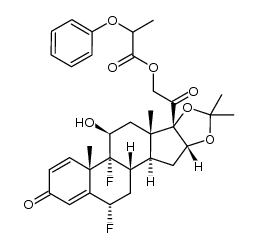

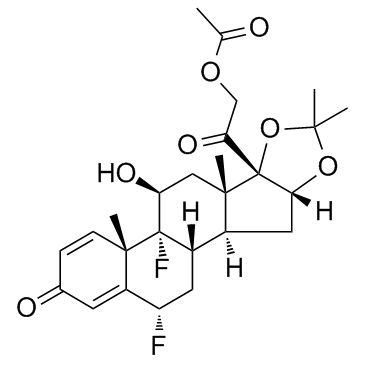
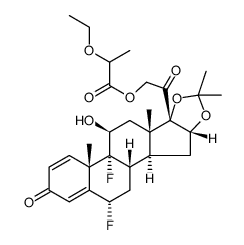
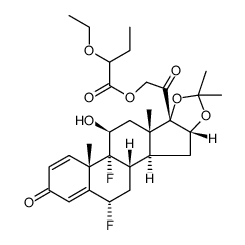


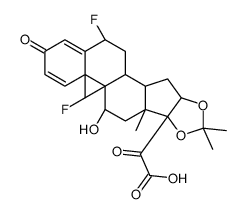 CAS号106931-78-6
CAS号106931-78-6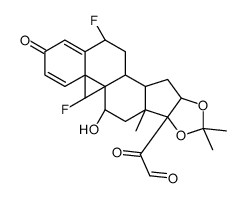 CAS号13242-30-3
CAS号13242-30-3
